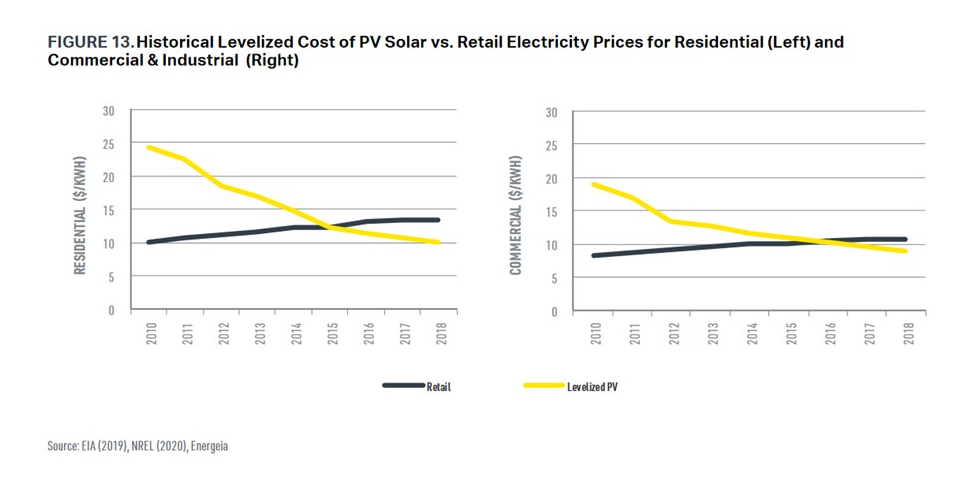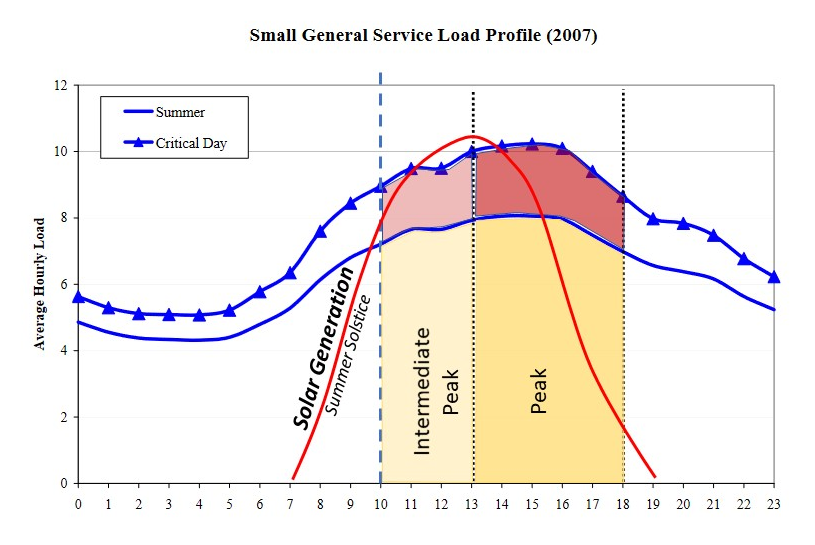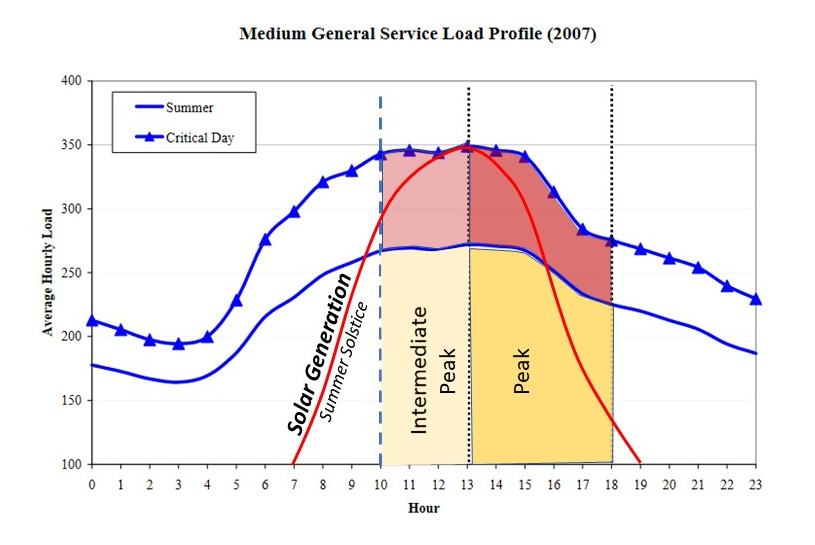Solar Power and Municipal Electric Utilities in Kansas
Solar Peak Load Generation
Evergy Central is greatly overbuilt in baseload capacity and is urgently trying to sell long-term 100% power provider agreements with cities, school boards, and other large customers. Their investments have been based on the historical assumption that baseload power is cheap and peak load is expensive. And because renewables have been so marginalized in Kansas, this paradigm is always reflected in utility rate decisions. Since 2015, that assumption has been turned on its head. Distributed solar peak generation, especially with zero cost for delivery, is now less expensive than utility electricity. Evergy’s subsidiary, Evergy Energy Partners, agrees that town-sized solar arrays can provide peakload energy at 2.8¢/kWh.
The Kansas Legislative Coordinating Council authorized a study of retail rates of Kansas electric public utilities. The second “Lightly Redacted” part came out in Oct 2020. “A Study of Consequential Issues Materially Affecting Kansas Electricity Rates,” Advanced Energy Solutions, (distributed or rooftop solar, Pgs 59-74). It shows the savings offered to municipal utilities by customer-located solar arrays, not from generation, but due to reduced line losses and in allowing the transmission and distribution systems to be sized closer to base load capacities:
And these savings are consistent across all customer classes: residential, commercial, and industrial. PV shows little effect on generation savings because energy is largely bought from one source, but transmission and distribution are significant, especially for distribution-only utilities. The odd part of this graph is that Evergy has the same number of meters per mile as the Kansas City Board of Public Utilities or Garden City. Yet it reports about a fifth of the savings to its transmission and distribution system. Why would they understate savings? Evergy Central is adding $5.9 billion to its rate base for rebuilding its delivery system. Admitting that rooftop solar could save ratepayers a large portion of this expense undercuts their justification for increased rates before the Corporation Commission.
This discrepancy between a central generation-only model and the new economics creates a crease where change can happen rapidly in Kansas. The emerging model is centralized wind baseload and rooftop solar peak generation. Especially for distribution-only utilities, such as municipal and rural electric cooperatives, this is a possibility to leapfrog past the centralized electric model we’ve lived with for a hundred years. Beginning this year, 2023, non-profits including churches, schools, municipal buildings, or coop groceries qualify for direct rebates from the IRS. There is a common delay in these payments because they are applied for at the time the system is installed, but the rebate is repaid within 4 months of your submission of the IRS form 990 at tax time.
These are steps your town might consider:
- In the last few years, Evergy has contracted with cities, school boards, and universities around Kansas to sign them into long-term and 100% power purchase agreements. Don’t let the urgency of increasing prices and finding a new power source push you into exclusive or long-term power contracts. Your options are changing very quickly.
- Of course, start with efficiency, all the actions you already know to do.
- Select as demonstrations city and small business buildings which already have a load profile that matches solar power production, i.e., schools open at daybreak and close ~4:30 pm, or offices that open at 9:00 am and close at 5:00 pm:
Summer Solar Generation Curve from the Nat. Renewable Energy Laboratory and the KCC/Westar Time-of-Use Periods
Westar load profiles from “THE IMPACT OF DYNAMIC PRICING ON WESTAR ENERGY, by Dr. Ahmad Faruqui, Smart Grid, and Energy Storage Roundtable, Topeka, Kansas, September 18, 2009“, with superimposed National Renewable Energy Laboratory Solar curve
The Intermediate Peak period, from 10am to 1pm, is never mentioned in Kansas Corporation Commission rate hearings.
- These will minimize the amount of storage or backup power needed to fill in the early and late hours of the day. Offices or small businesses, or as you can see above, relatively large businesses realistically should require very little further cost/benefit study. City and school buildings as well as other non-profits now qualify for a 30% rebate for the cost of the system. These rebates can also be “stacked” with other grants and rebates such as USDA REAP grants to make solar energy pay even faster.
- Many businesses also have this use pattern. They can use tax credits and accelerated depreciation to give a fast return on their investment and then have nearly free electricity for 20 years. You can incentivize them in several ways, but true net metering is the simplest and most effective.
- As the graphs show, these savings for your businesses, city offices, or school districts are disproportionately from the most expensive electricity hours and stay to recirculate in your community.
- By the time you’ve completed studies on the city’s power requirements, reliable storage will be available at good prices. This is being driven by markets in California, New York, Hawaii, Germany, China, and Korea – too many places to name. The competition is very stiff, and Kansas consumers will benefit as a side-market. We can look at customers that don’t exactly match the solar profile but are already so competitive with centrally generated electricity that investor-owned utilities are scrambling to block their market from residential rooftop solar.
- Contrary to what the investor-owned utilities present, residential and small commercial or city buildings are connected to the same feeders and substations. As people leave home for work, systems on home rooftops are generating power for neighboring schools or offices. It is of minimal importance to prevent excess power from feeding back onto your lines. Your city has to buy less of the expensive peak power. Hawaii and California are pioneering grid integration opportunities with storage and two-way communications with interconnected inverters. By the time Kansas has the market penetration of either of these states, we will have storage choices at a fraction of today’s prices.
Today it makes sense for municipal utilities to invest in generating their own peak load power and buying inexpensive wind baseload from the open market – central baseload and distributed solar peak.
Timing is Crucial
There is a growing recognition among both parties that climate change will bring increasing numbers of critically hot days. Recognizing the urgency of climate change, the Inflation Reduction Act has extended the credits another ten years and offers great opportunities to make solar energy work for your town or school system. Those municipalities which understand their options may be prepared to apply.
We would be happy to work together, again in our role as a non-profit, with any portion of bringing solar energy into your utility’s plans.
FHREEC can offer:
- Our best understanding of reliable suppliers and hardware.
- We’ve taught solar energy at our community-free university for thirty years and would be happy to do the same (PV 101) at a community center in your town.
- FHREEC helps in demonstration installations called SunRaisers for families to teach neighbors, local contractors and municipal employees that installing an array is not beyond the abilities of most people. The array portion of the hardware is plug-n-play, with no high-voltage DC and no live electrical work until your electrician completes wiring back to the breaker panel.
- If we can network with five or six rural electric cooperatives and municipal utilities, we can order together in shipping containers instead pallets. We can already offer prices close to matching utility-scale projects – but with the advantages of peak generation at its point-of-use. The price advantages we can gain by buying full containers directly from the factory will be 20-30% lower than those on our most recent price sheet.
- Or please, suggest any other way we can help.




